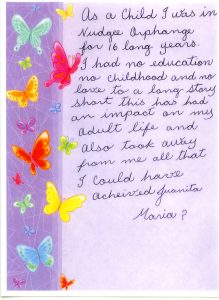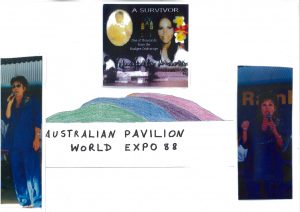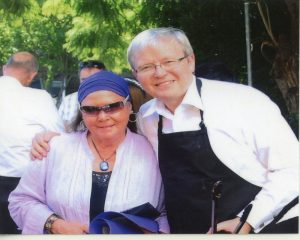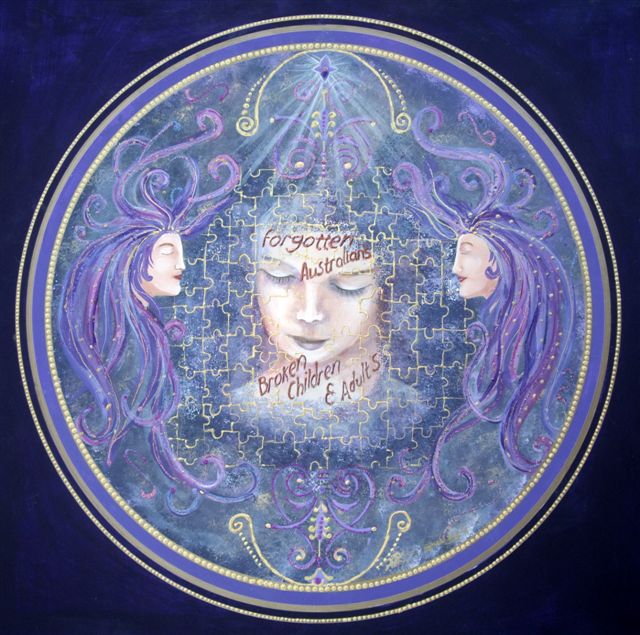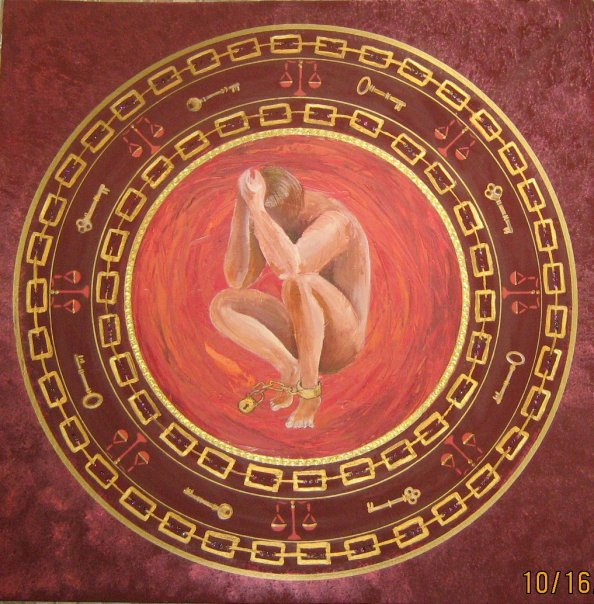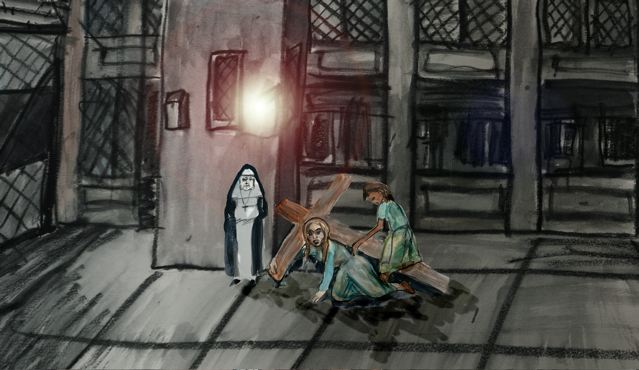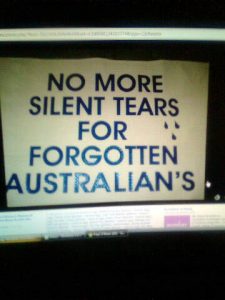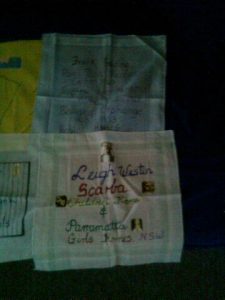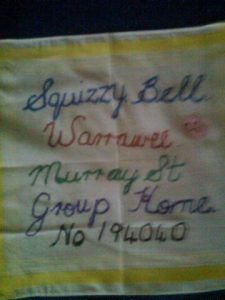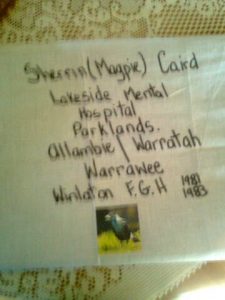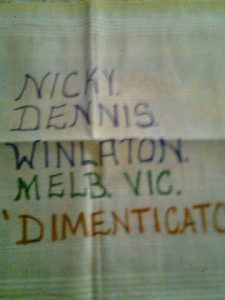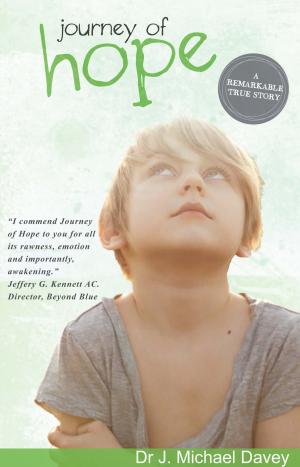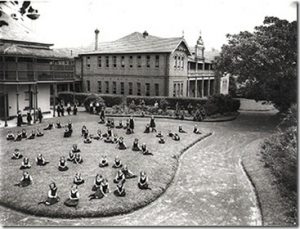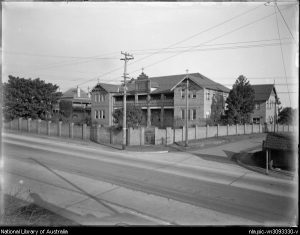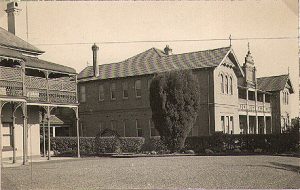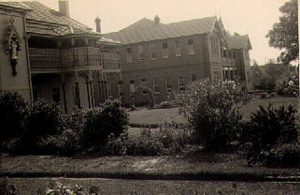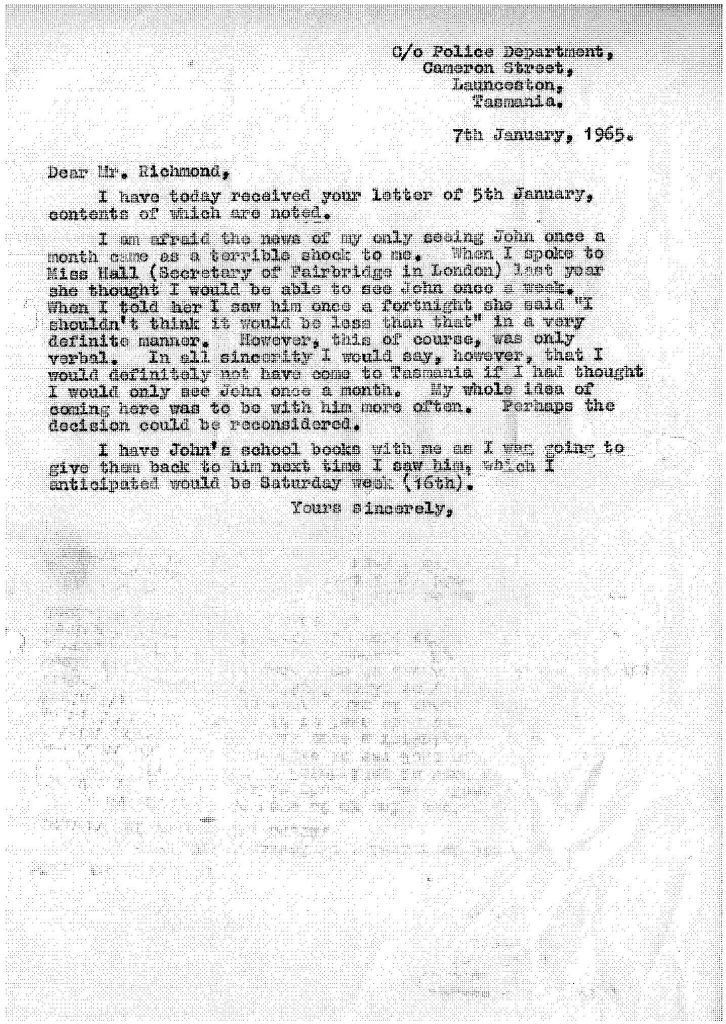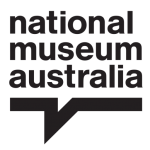Juanita Maria Burr, nee Broderick, was a resident of Nudgee Orphanage, Queensland, from 1944 (the year of her birth) to 1961. Here she shares some recollections, including photos of her singing at the World Expo, 1988, Brisbane.
Category: Forgotten Australians
Healing mandalas
Schwarten Inquiry into Westbrook
‘The Superintendent said, “Don’t look at me in that tone of voice” and banged boy 90’s head several times against the tin wall’. Read the full 1961 report of the Inquiry into Westbrook Farm Home for Boys by Stipendiary Magistrate, Mr AE Schwarten.
The report was conducted after an ‘incident which occurred on Sunday, 14th May, 1961, at the Farm Home for Boys, Westbrook, in which approximately 36 inmates of the said Home were involved and number of whom escaped’.
The report was provided to the National Museum of Australia by Al Fletcher, author of Brutal: Surviving Westbrook Boys Home by Al Fletcher as told to Cheryl Jorgensen. The report has since been published online by the Queensland Government.
Download a copy of the 79-page Westbrook Farm Home for Boys Inquiry Report (PDF 6.92MB)
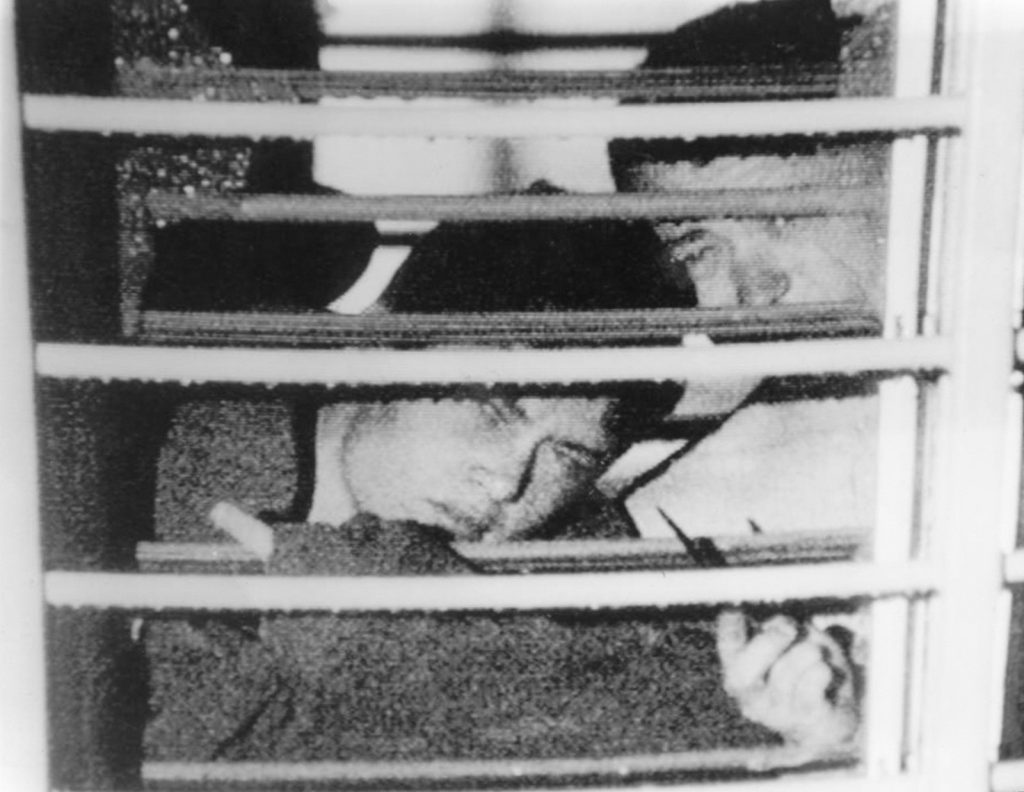
‘A Call for Justice’
Michelle Greaves shares ‘A Call for Justice’, a song recorded by her twin brother, Mark Torr. It’s dedicated to all those who spent time in Children’s Homes and Institutions. Michelle and Mark were sent to Darling Babies Home, Victoria, at the age of two and then, three years later, to Nunawading Cottage, St John’s Home for Boys and Girls.
Mark talks about ‘A Call for Justice’:
This song is a dedication to all that have endured loneliness and hardship throughout their journey from the innocence of childhood to becoming an adult.
It is a call for justice for those that suffered abuse at the hands of the very people that were charged to protect them.
This song represents a collective call for justice for one and all.
It is a recognition that many came from all walks of life, Orphanages, Foster Care, Child Migrants, and from within Church and Government institutions.
It is also dedicated to all those that have fallen along the way and no longer walk amongst us.
Stand Proud Stand Tall
Your brother your friend Mark …
‘Warrior’s Journey’
Author and counsellor Margaret Spivey lived in Children’s Homes from the age of 18 months to 17 years. ‘Warrior’s Journey’ is Margaret’s powerful poem tracing life in welfare and beyond.
‘Warrior’s Journey’ was published in Beyond the Tobacco Bush, Beyond the Cocoa Bean (2003), and Warrior’s Journey (2003).
Warrior’s Journey
Father dies
mother leaves
sisters taken away.
Helpless, defenceless.
No hand to cling to,
Welfare Property
Ward number 77318
another number, another mouth,
another body, another untouched soul,
another heart to be healed,
another shadow in the dark of night.
She is two years old.
From one dwelling to another she is sent.
Disconnected, her child’s heart broken, the need for love
Unquenched.
A vacuum for her confidence and sense of self;
anxiety and anger her constant companions
she struggles to belong, she doesn’t belong.
Hands shake, body trembles,
cries unheard, muffled under bed covers.
She is ten years old.She thinks of death to escape the anguish.
She believes she has no right to take up space,
to breathe air.
She believes there will be rejoicing at her passing,
a problem solved.
She releases the genie in the bottle,
life goes on about her,
she closes her eyes and waits.
She is marked. She is spared.
Like the first born of the Israelites, the Angel of Death passes her by.
She is twelve years old.Tormented by anger, a prisoner of rage.
Her cries for justice, she fights to be heard.
They say, ‘she’s a psychiatric case’
and needs to be medicated.
Silence her voice, dull her mind, and inhibit her strong emotions.
She must endure the rash, the itch, the weight gain, the hand tremors, and the sluggish thoughts.
Now they say ‘she’s boring with no powers of conversation’.
In school she sits, eyes heavy; she drops her head – just for a moment.
She sleeps her days away.
She is fourteen years oldShe hears the call of the warrior soul.
She resists sedation; the murder of her spirit.
Pills hurtle across the fence, a cry goes out
‘I won’t do what you want any more!’
Strong male hands force her down, inject her into submission.
They say ‘it’s for her own good and for the good of others’.
She is ‘disturbed’, ‘mad’, emotionally retarded’.
She is fifteen years old.She is released, pushed out into a world of strangers.
They don’t understand or care about her sorrow.
She must find work, forge relationships, and build a life. There is no help, there is no social net to catch her, and there is no family to
give her connection.
She must find her own way.
She is lost, jobs are transient, and relationships unravel.
Booze is her solace, drugs her respite, madness her rescuer.
The streets her home.
She is seventeen years old.She is a mother;
frightened, solitary,
how can she care for the infant in her arms?
She needs help, she reaches out,
her children are removed.
She can’t be trusted, she can’t trust herself.
It’s for her own good ‘in the best interest of the children’.
She seeks the comfort of death,
but death rejects her plea.
The ‘Warrior Soul’ calls her to life.
She yearns to be a mother, she craves to do it right,
Her children are ‘restored’,
She is twenty-four years old.A single mother, living in poverty.
She hears the call of her warrior soul
She needs to dream, she needs to believe,
She needs to hope.
However, she is mad.
Her mind has betrayed her,
what can she anticipate?
The pills, the booze, the violence.
How can she break the will to self-annihilate?
She is determined.
She must find a way.
She is twenty-seven years old.
She treads the road of trials,
She cries out ‘there is no God!’
Lost within her madness,
admitted to the Clinic.
‘What is wrong with me?’ she pleads.
She is thirty-three years old.The warrior soul is stronger
than the darkness, that binds her.
She heeds its call.
Is there a God? She prays to believe.
She dares for more than mere survival,
she crawls out from within the sewage of her life.
She is thirty-six years old.Her untaught soul greets the morning.
She discovers she is far more than all her experiences.
More than her illness.
She knows now, in each one of us
there is a gold of great worth.
There is a warrior soul of strength and courage.
Compelled to transform her suffering.
she studies, she learns, she grows,
finds enduring love, personal value.
She connects.
Passes on her hope,
helps others finds their way.
Sometimes death still whispers her name,
however, she grips the hand of the warrior within,
she has learnt to trust.
She has found power and strength within,
She is forty-five years old.
copyright Margaret Spivey 2003
‘Those Long Lost Years’
Graham Evans, who was sent to st Vincent’s Boys Home, Westmead in 1962, has been contributing to this website since it began. Read Graham’s latest song lyrics.
Those Long Lost Years
If I could take you back to times when we were young
All these stories of abuse you hear, have not just begun
It’s been our life time, and no one can really see
Except the abused and my friends, what’s left to beWe’ll we fight for justice, and our equal rights
Because we’re fully pledged ‘Forgotten Australians’ both day and night
And we’re so tired of lying down with these silent tears
But! what do you expect, after all ‘Those Long Lost Years’It’s been our life time, and no one want’s to see
Not the Churches, the Government’s themselves, nor Society
Well we’re so tired of lying down with these silent tears
But what do you expect after all ‘Those Long Lost Years’Yah! It’s been our life time, and no one want’s to see
Not the Churches, the Governments themselves, nor Society
Well! we’re not going to lye down no more, we’re going to stand and fight for our cause
But what! do you expect, after all ‘Those Long Lost Years’
And what do you expect, after all ‘Those Long Lost Years’.
Sudden death of psychiatric patients
by Pat Brodnik (guest author) on 8 August, 2011
‘People are dying and even the press is starting to report these deaths, amazing …’ writes Pat Brodnik, who shares an article from The Age about the ‘unexpected, unnatural or violent’ deaths of 200 Victorian psychiatric patients.
You can read the 1 July 2011 article, ‘200 psych patients died suddenly’, on The Age website.
‘Religious life is dying’
by Oliver Cosgrove (guest author) on 8 August, 2011
‘We noticed that the abuses happened when the Christian Brothers were at our strongest. We were thriving in terms of vocation, power and money. The government would not dare to question us.’ Read an interview with Brother Philip Pinto, head of the Congregation of Christian Brothers, who says religious life in its traditional sense is ‘dying’.
You can access the 5 January 2011 article on the Conference of Religious India Bulletin.
‘The stain is indelible’
by Rachael Romero (guest author) on 5 August, 2011
Artist Rachael Romero, who was in the The Pines, the Convent of the Sisters of the Good Shepherd in Plympton, South Australia shares her painting Pines Quadrangle dark with station of cross detail.
Rachael describes its significance:
It was dark the first time I crossed that cement quadrangle–at first I thought I was on the deck of an old ship. I had entered a new confinement.
It was clear that I had been condemned–that my prior life was over. That I was despised by my new jailers.
That the life that loomed before me was now even more dreadful . The idea that I would have to endure an unbearable seven years until
I reached twenty-one and had the power of my own volition was agonizing.
They knew not what they did.
Now they wash their hands, but the stain is indelible.
Apology for forced adoptions?
by Wilma Robb (guest author) on 26 July, 2011
Catholic Health Australia chief executive officer Martin Laverty says that he is prepared to apologise to the victims of forced adoptions, according to a recent report.
You can read the 25 July 2011 article on The Daily Telegraph website.
Another report on the ABC News website discusses responses to Archbishop Barry Hickey’s comments regarding adoption.
Forgotten Australians demand more than apologies
by Adele Chynoweth on 20 July, 2011
Journalist Neena Bhandari discusses the needs of Forgotten Australians and former Child Migrants in her article ‘Forgotten Australians demand more than apologies’.
Published on 20 July 2011 the article covers the compensation needs of Forgotten Australians and former Child Migrants, as well as their need to find family members.
[2020 note] You could previously access this article on the Rogers Digital International website.
‘Sleep Well Tonight’
by Darren Sugars (guest author) on 19 July, 2011
Darren Sugars sings ‘Sleep Well Tonight’, an original track which he says is ‘inspired by the personal narratives of two brave Forgotten Australians who are dear to him’.
Thanks to CLAN for providing the National Museum with a recording of the song.
‘Sins of a Child’
by Rosie Klohs (guest author) on 18 July, 2011
‘No longer a number – my name is Rosie’. Rosie grew up as number 20280. Her experience as a state ward left her with post-traumatic stress disorder. She’s now in recovery and a Remembered Australian and made a short film about her experiences.
Rosie Klohs’ film, Sins of a Child, was published on the Moving Minds page on the Mental Illness Education ACT website.
Defying the Gatekeeper
by Margaret Spivey (guest author) on 18 July, 2011
‘I conducted an archaelogical excavation of my past …’ Listen to Margaret Spivey talk about her autobiography Defying the Gatekeeper: One Girl’s True Story of Resistance and Rebellion.
Defying the Gatekeeper is published by JoJoPublishing, VIC.
No more silent tears #2
by Leigh Westin (guest author) on 14 July, 2011
Leigh Westin, who grew up in Scarba House and Parramatta Girls Home, is creating a memorial entitled No More Silent Tears for Forgotten Australians. The memorial is comprised of a large panel of handkerchiefs sewn together, each decorated by those who spent time in a Children’s Home or institution.
If you experienced institutional or out-of-home ‘care’ and would like to contribute to this memorial, then on a lady’s-sized handkerchief embroider and/or write in ink, your name, the name of the institutions(s) and the year(s) that you lived there. Please feel free to decorate it however you wish, so that it will be suitable for people of all ages to view. The important thing is that you only use a lady’s handkerchief so that Leigh can easily sew them together. You may, of course, make a handkerchief in order to remember a Forgotten Australian or former Child Migrant who has passed away.
You can then post it to:
Adele Chynoweth
National Museum of Australia
GPO Box 1901
Canberra ACT 2601
Adele will then pass the handkerchiefs onto Leigh. Please make sure that your contribution reaches Adele by close of business Friday 12 August, 2011.
Below are some of the handkerchiefs that have already been made.
‘Journey of Hope’
by Adele Chynoweth on 14 July, 2011
Listen to an interview with Dr Michael Davey, former ward of the state and author of ‘Journey of Hope’, on ABC Radio National.
Dr Davey recalled his experiences in foster care and at Royleston Boys Home in Sydney during an interview on the ‘Life Matters’ program on 14 July 2011.
Download the ‘Journey of Hope’ interview on the ABC website.
Journey of Hope is published by Arkhouse Books.
Medical testing on children
by Tom Thompson (guest author) on 12 July, 2011
The University of Melbourne, in 2009, acknowledged its prior use of children in orphanages as human guinea-pigs in medical research. Read Tom Thompson’s recollections of men in white coats giving him injections at a Children’s Home in Parkville, VIC.
Tom, who never owned a picture of himself when he was a child, received the image below just four years ago.
I’ve two scars on my left arm from medical testing of the antigen vaccination for the seed Salk Polio vaccine, done in the late 1950’s.
I don’t know the actual dates in which the different injections were given, as I’d never been to school or known what it meant for days of the week, months or years. I do however remember the events due to the pain and distress we endured.
I vividly remember being lined up before the men in white coats who came and gave the injections which blistered and caused so much pain.
Our life in the homes was strictly regimented and having strange men in white coats was something not to be forgotten.
I spent nearly 6 years in the Victorian Children’s Aid Society home at Parkville Victoria. Just across the road from Melbourne University and the Eliza institute in the same street of Parkville. Both institutions were involved in advanced medical research at that time utilising institutionalised children as guinea pigs.
Both institutions have acknowledged their culpability in this research and publically apologised, however like Dr Joseph Mengele who experimented on children in the concentration camps and was on the wanted list for (for over 40 years) and the Nuremberg trials over his barbaric experimentation on children, he escaped capture and prosecution and lived out his life in South America.
I believe these institutions and CSL [Commonwealth Serum Laboratories] should be tried for what they’ve done. Under law there is no statue of limitations on culpable homicide. The vaccine used in the early tests was contaminated and known to cause cancer and other health problems.
Some of the original ‘seed’ polio viruses that had been originally obtained from Salk laboratories in the United States of America in 1955 and used to manufacture Australian polio vaccines tested positive to being contaminated with SV40, and yet was still manufactured and utilised by these organisations on children.
Tests in the late 1950’s and early 1960’s confirmed that SV40 was potentially carcinogenic.
I live each day not knowing when or if I will fall victim to some unknown disease.
Governments, medical institutions and health authorities all shout loudly how we should trust them, as they know best, but like Joseph Mengele, the people time and places change, but things really stay the same.
The photo is me at an age I don’t know, it was given to me by Professor John Swan 4 years ago, and was taken at the home in Parkville. The Swan family took me out of the home for weekend visits over a number of years. The photo was taken by Dr Ailsa Swan (who has since died).
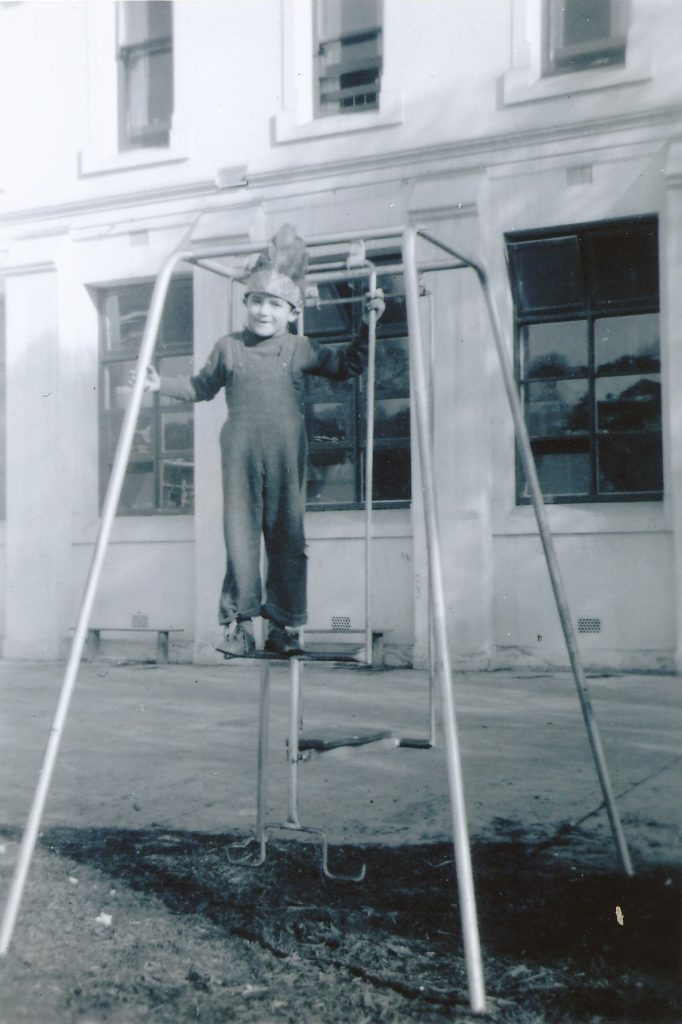
More
‘Melbourne Uni says sorry for trial on orphans’ 2009 report on The Age website
‘Polio vaccine tested at orphanages’ 2004 report on the Age website
‘Institutions, the convenient laboratories’ 1997 report on the Age website. This article won the Melbourne Press Club Quill Award.
‘Vaccines tested on Australian orphans’ as reported in The Independent, UK, in 1997.
A child’s letters to the welfare department
by Priscilla Taylor (guest author) on 11 July, 2011
A child’s letters to the South Australian Children’s Welfare chairman help to tell the story of a young woman who spent 16 years in care, and later discovered her mother had written many returned letters to her daughter.
Priscilla Taylor (then Phyllis McMorran) wrote the letters to Mr Cook, Chairman of the Children’s Welfare and Public Relief Department of South Australia in 1961 while she was living in a Foster Home.
Priscilla explains:
While growing up I would cry for my Mother, I would then be told, don’t worry about her, she doesn’t want you. Nobody wrote to me, so during letter writing night I would write to Mr Cook. While it was good of him to reply, I would have preferred letters from my Mother. Yes Mum did visit when I was in Seaforth, a Government-run Home, but during my 16 years under the Welfare, I only spent months, numerous times living there.
During the Mullighan Enquiry, Ted Mullighan asked for a support service to be set up for us. This was the beginning of Post Care Services SA, for Forgotten Australians. While attending Post Care, I spent time coming to know a Brother and Sister. One day the Brother mentioned this lovely lady who had looked after them and given him the happiest of his growing up years, until she died at 50 years of age. Under this ladies bed she kept a box of returned letters, she had written to her two daughters. Yes these letters belonged to me, this beautiful lady was my Mother, Phyllis Dawn Pring. After receiving my files, I also learnt that Mum had also be lied to, and had applied to the Courts of SA, to gain custody back on several occassions.
So as you see, some things are not as they appear.
Read Priscilla’s letters (PDF 180kb) and a response from Mr Cook.
Senators vote against child abuse inquiry
by Wilma Robb (guest author) on 7 July, 2011
The Australian Senate recently voted against Senator Nick Xenophon’s motion that the Heiner Affair be referred to the Legal and Constitutional Affairs References Committee for inquiry and report. Listen to Bravehearts‘ founder Hetty Johnston’s response.
Download the Hetty Johnston interview with Michael Smith on the 2UE website.
Download the Hansard excerpt (PDF 263kb) to read the report of the Legal and Constitutional References Committee discussion and to see how senators voted on 23 June 2011.
Eulogy of Christiana Imelda Ramsey
by Leicester Ramsey (guest author) on 24 June, 2011
‘Christiana, in our eyes you were a success’, said Leicester about his mother at her funeral. Leicester’s eulogy is an account of his history and a tribute to Christiana. It also offers insights into how children were institutionalised in Australia.
Eulogy of Christiana Imelda Ramsey
Christiana Imelda Ramsey was born on 26th December, 1925 in St. Murdock’s Terrace, Ballina, County Mayo, Eire. She grew up in Limerick. Her parents were, Tom Daly and Mary Daly nee Hayes. Christiana’s parents eloped when her mother Mary was only 16 years old and they were married in England in 1920. Her grandfather, Pat Hayes, never forgave his favourite daughter, Mary and never spoke to Mary or her children for the rest of his life. He never forgave them for eloping, even when Christina’s mother Mary was ill in bed for nine years dying at the age of only 43.
Christiana always loved her mother and missed her for the rest of her life. She would often recall many fond memories of her time with her mother.
Christiana would recall visiting her grandfather’s farm at Palace Green for holidays between the ages of 4 to 8. She had been told she was not to talk to her grandfather, or even wave to him when he was watching from the window.
Christiana was one of 10 children: 6 girls 4 boys. Her father, Tom Daly, a mechanic by trade, was one of the founders of the original IRA. He was a TD, which is a member of the Republic of Ireland Parliament. He was also involved in the 1930-31 riots in Ireland. He drove the first bus in Dublin and also raced cars.
Christiana met many famous people in her life, including de Valera at the age of 5 and Michael Collins.
Christiana was proud to tell all those who would listen, how she sang in the St Johns Cathedral choir, Limerick at the ordination of a bishop.
At the age of 15 Christiana left home to start work doing cleaning jobs and errands for well to do families. After several years, she decided it was time to look for husband. She advertised in the paper and received many offers. These included a jockey. She decided to meet a Mr Harold Franklin Ramsey, a wealthy self made man who was looking for a house keeper, not a wife. On meeting him she accepted a job with him and over time they fell in love, a love that was to last the rest of her life. Even though there was a 33 year age difference between them. Sadly, he died when Christiana was in the prime of her life. She never remarried nor had a partner, because of her love for Mr Ramsey.
They were married twice, once in 1946 Royal Court England and in 1951 on Jersey in the Channel Islands.
Christiana and Mr Ramsey, as she often called him, travelled the world. They lived in Ireland, France, Switzerland, Ceylon, Jamaica and Jersey. They had 6 children and were internationalists before it was common. Their children were born in various countries, Anthony in Switzerland, Alan on Jersey, Michael and Chester back in Ireland and finally, Leicester and Malcolm in Australia.
After living and running a business on Jersey for 5 years, Mr Ramsey, who had been told stories about Australia by his friend the BBC war time correspondent Chester Wilmot decided to emigrate. Mr Wilmot was the author of the book ‘Struggle for Europe’. They decided Australia was the place of the future. So they set of from Jersey in 1949 motoring through France, Italy, Greece, Yugoslavia, Turkey, Syria, Israel, the Holy Land, Jordan, Saudi Arabia, Iraq, Iran, Pakistan and India. In India they visited, amongst other sites, the Taj Mahal. Christiana always said that it was one of the most beautiful sites she had ever seen. From India they went to Ceylon, now Sri Lanka, where they waited for 6 weeks to catch a boat to Fremantle, Australia. On arriving in Australia, they were greeted by a reporter from the Western Australian newspaper. They were front page news for having been the first to travel by car from England to Australia, arriving in 1954.
They arrived with 4 children, Anthony, Alan, Michael and Chester. Leicester and Malcolm were born later in Australia.
After arriving in Fremantle, they then set off across the Nullabor Plain, which was then just a dirt track, to Victoria. Then they travelled up the east coast to NSW passing through Kiama, to Sydney. Not finding what they wanted, they returned to Kiama to settle. Kiama reminded Christiana of Ireland, with the green hills.
They set about finding land to build a garage and motel which they called the Shamrock Motel. The land was purchased at Ocean View.
Later, Christiana was contacted by her sister Mary. Mary asked if Mr Ramsey would pay the travel fares to Australia, for Mary, her husband Bill and their children so they could emigrate to Australia. Mr Ramsey and Christiana needed an assistant to run the hotel. So, they agreed, on the condition that Bill would work for Mr Ramsey until the money was paid back. Bill Wilson worked for a few months and never repaid the money owed. In fact, he not only refused to pay the money back, but 6 weeks before Mr Ramsey died, Bill Wilson, then 33 years old, attacked and punched Mr Ramsey, leading to his death soon after.
Christiana at 33 years of age was left widowed to raise 6 boys, the eldest 12 and the youngest 3 months. With no family or friends to provided support and help she was struggling to manage the running of a motel and garage. She was also struggling emotionally from her loss. Eventually, she suffered a mental break down and neglected to get all the children to school.
The authorities, concerned with the lack of attendance at school, called the police. The family property was raided, the front door was kicked in and the family dog was shot. The children were forcefully removed from Christiana. The children were then placed in the Bernardo homes at Kiama. Mary was not happy to have the children brought up in the Protestant faith of their father. Also, Mary was concerned about the environment of hate that existed between the Catholics and the Protestants in 1960s. She contacted Father Phibbs, then head of the Catholic child welfare bureau. Fr Phibbs made an application through the courts to become the guardian of the children until each one turned 16 years of age. He also had power of attorney over an estate worth in excess of 100,000 pounds. In today’s terms that would have amounted to millions of dollars. To this day, this money has never to be accounted for.
The children were then placed in St Joseph’s, St Michael’s and St Vincent’s Westmead. These unlawful acts were recently recognised when the Federal and State Governments apologised to the FORGOTTEN Generation and these children were invited to the ceremony.
Christiana in the meantime was placed in mental institutions and given shock therapy. After receiving treatment, she found work at the Australia Hotel making beds and cleaning rooms. Later she got a job with the Catholic nuns at Rose Bay, where she was allowed to have Malcolm, her youngest son, live with her.
In 1966 she managed to rent a property in Jersey Road, Woollahra, for 6 months. This allowed Anthony, Alan, Leicester and Malcolm to live with her again … [she was] … again institutionalised.
After recovering, she again gained employment. She visited her family by walking from Sydney to Westmead. Upon arriving she was told that she had missed visiting hours and she could not see her children. Saddened, she then had to walk all the way back to Sydney.
Over the years she asked many times to be provided with money from the family estate. She wanted the money so she could buy a house and raise her children, all to no avail.
In despair, she wrote to Sir Roden Cutler, the Governor of NSW at the time. She was seeking assistance to get a housing commission house so she could raise her children. After being on a waiting list for 8 years, in December, 1969, through Sir Roden’s help, she got one in Green Valley, bringing her 3 younger children together for Christmas.
As the years rolled on, Christiana lived to see her children and grand children, grow and become successful. Although much of her life was lived in poverty, all she ever wanted to be, was a good wife and mother.
Christiana in our eyes you were a success. You were a wonderful person. You were an inspiration to us all. You were a mother to your children and a grandmother to your grand children.
You achieved your aims beyond your expectations.
You will live on in the hearts of all that knew and loved you, down through many generations.
We love you and will miss you.
God Bless You and keep you in his love.
Shock treatment
by Gwen (Sandra) Robinson (guest author) on 22 June, 2011
‘My heart broke for these defenseless people and still does today.’ Gwen (Sandra) Robinson was placed in Wolston Park Hospital, Tufnell Home and Home of the Good Shepherd Mitchelton. Here, she remembers her experiences at Wolston Park.
Gwen writes:
My name is Gwen Robinson preferably known as Sandra and I am going to write a little about the Shock Treatment that I seen given to patients at Wolston Park Mental Hospital also known as Goodna Mental Hospital. First I will tell you a little about myself and how I got there. I was put in there for being an absconder, better known as an habitual run-away, and not because there was anything mentally wrong with me which was proven by the I.Q. test that I did there and it came out as above average. I had the brains to be an accountant, which is what I wanted to be, but I was never given the education to follow that profession. There is a letter in my files written by a doctor to the Childrens Department stating that Wolston Park was non-theraputic to me and I should be out in a hostel and doing a business course. Needless to say that never happened and the Childrens Department just kept me there to be kept drugged up. We were given a drug called peraldahyde and it had to be given in a glass vial as it melted plastic. The mind shudders as to what it has done to my body being given to me as a young teenager. We were also given other mind altering drugs which kept us immobilised, which led to some of us wetting or dirtying ourselves as we could not move. It also left the staff free range to do whatever they wanted when we were in this state. I have cigarette burns on my arms from the staff and other scars.
I absconded from Tufnell Home and ended up in The Good Shepherd at Mitchelton and then I got out of there and was sent to Karalla House. I never got out of there but was locked up for more than a month in solitary confinement and when we got out of these rooms we came out as mad as hell and caused trouble and then this led me to be put in the Mental Hospital as it was the most secure place in QLD to keep me. I got out of there and was caught months later and was locked in a room for 2 weeks for the male staff to have access to as this was my punishment. I was also told at this time that if I escaped again that there was a lot of suicides in the Bremmer River. I believed them as I thought if you can lock me up with the Criminally Insane, and no one is doing anything about it, then you could do exactly as you pleased. Needless to say that I did escape from there one more time and was never caught, but I lived a life of being someone else as I thought I would be murdered. If anyone is interested I could explain that to them. In my mind I have never deserved any of this treatment as my only crime was being an orphan and being severly bashed at home and sometimes so bad that the school took me to the Hospital as I had blood and welts all over my body.
I cannot remember the number of the Ward that I was in when I witnessed the horror of seeing people being strapped down for shock treatment and also seeing them come out of the room when it was done. I am sitting here writing this with tears in my eyes as the pure horror of what these people went through comes back to me. It was one of the cruelist things that I have ever witnessed. The patients would fight the staff and come and hide behind other people, such as myself, and beg us to help and protect them. There was nothing I could do and they would be dragged away by staff and they would be begging and pleading to the staff not to do this to them. When they came out of the rooms after Shock Treatment they would be left lying on the beds and this is when I seen male staff interferring and doing sexual things to some of the patients while they were unconscious. Even today thinking about it makes my stomach heave. I have always been quite a strong person and have had a strong sense of survival, but what I seen in this place and also had done to me has had the worst effect on me even these many years later. Sometimes for days and even weeks these patients who had Shock Treatment would walk around in a daze with strange eyes, like they couldn’t focus, and also loss of memory. They were forever asking others what their names were and where they were. Another thing is that they were very skiddish as hiding behind other patients, such as myself, so as not to be noticed by staff and if staff came towards some it was like they were frozen with fear and I witnessed some patients just pass out with this fear and some of the staff thought this was quite funny. My heart broke for these defenseless people and still does today. Everyone dreaded Shock Treatment days but some of the staff loved it.
The Government in QLD. will not compensate any of us who were children placed in Adult Institutions or who were locked up with the Criminally Insane. They keep saying that the Redress Scheme has closed but they fail to realise is that these Mental Institutions were not covered by the Redress Scheme as it only covered places in the Terms of Reference for the Forde Inquiry and this Forde Inquiry did not let us speak of these Mental Institutions and we were told that they would never be included as it was a seperate issue. None of us have ever found a lawyer who is smart enough or has the fight to take on the Government or Health Department on this issue. Even the legal part of the Senate Inquiry says we should be looked at again for compensation as it was wrong that we were excluded as we were put there by the Children’s Department.
St Brigid’s
by Coral Miller (guest author) on 21 June, 2011
Coral Miller shares photographs of St Brigid’s Girls Home, Ryde, NSW. Coral and her sister were sent to St Brigid’s for five years after their mother had a breakdown when their father was killed in Malaya at the Parit Sulong Massacre.
Visitors
by Rupert Hewison (guest author) on 10 June, 2011
A letter from the mother of former Child Migrant Rupert Hewison outlines her ‘terrible shock’ at moving to Tasmania to be closer to her son, only to find her visits limited to once a month. The Senate Report on Forgotten Australians (2004) noted that visits from family members were ‘keenly anticipated’ but ‘highly regulated in many institutions’.
The letter from Rupert’s mother to Tresca principal Mr Richmond reads:
C/o Police Department,
Cameron Street,
Launceston,
Tasmania.
7th January, 1965.
Dear Mr. Richmond,
I have today received your letter of 5th January, contents of which are noted.
I am afraid the news of my only seeing John once a month came as a terrible shock to me. When I spoke to Miss Hall (Secretary of Fairbridge in London) last year she thought I would be able to see John once a week.
When I told her I saw him once a fortnight she said “I shouldn’t think it would be less than that” in a very definite manner. However, this of course, was only verbal. In all sincerity I would say, however, that I would definitely not have come to Tasmania if I had thought I would only see John once a month. My whole idea of coming here was to be with him more often. Perhaps the decision could be reconsidered?
I have John’s school books with me as I was going to give them back to him next time I saw him, which I anticipated would be Saturday week (16th).
Yours sincerely,
Lowson House
by Jessica Dalton (guest author) on 10 June, 2011
‘I stopped correcting them, and certainly stopped respecting them’: Jessica Dalton describes her time at Lowson House, Royal Brisbane Hospital, in 1980. Jessica was 20 at the time but some of her experiences were similar to those recounted by Forgotten Australians who were admitted to adult wards of psychiatric hospitals as children.
I had taken an overdose after being dumped by my first boyfriend, and when I began vomiting I told my mother what I’d done. She took me to RBH where she worked and I was admitted to Lowson House where I was kept in isolation for three days on the locked female Ward D. Before being discharged, I was examined by a room full of doctors, students and staff. The registrar assigned to my case argued that I was schizophrenic and should remain in Lowson House for treatment. The psychiatrist invited me to give my version of events and I explained that I was very unhappy at home and when my boyfriend dumped me I wanted to die. However I didn’t die and I thought my best plan was to return to finish my schooling so that I could get a decent job or go on to uni and get out of home as soon as possible. He agreed with my interpretation of events and I was released.
When I was 20, I had finally made it to uni and had become extremely anxious prior to first semester exams. One night I couldn’t deal with the anxiety and walked to RBH and asked for help. I hoped that I would find intelligent reasonable people with expertise to help me deal with my emotional problems and mental distress. The anxiety was so excruciating that I told the doctor at admissions that if they couldn’t help I’d probably have to end my life. I was admitted to Lowson House again and the same psychiatric registrar I had met when I was 16, was appointed as my psychiatrist. She remembered me and told me that now I would get the treatment I should have received when I was 16. Although I had admitted myself voluntarily, I became an involuntary patient. I revealed that I had been sexually abused over the first 12 years of my life which I believed was the source of my mental distress, but this was interpreted as delusional, reinforcing the diagnosis of schizophrenia. I was heavily medicated, refused leave to attend my final exams, and refused leave to attend another doctor for a second opinion. I asked if I was entitled to a second opinion and my psychiatrist said that of course I was. So when I asked for leave she would smile and refuse. If I tried to discharge myself, I was put on an involuntary order and sent back to D Floor, the locked ward. If I refused medication, I was sent back to D Floor. If I refused again I would be held down by orderlies and nurses, have my jaw prized open and have syrup poured down my throat. I stopped there. The next step was injections. I couldn’t win that battle.
In the first few days on D floor I felt so heavily medicated that I used to fall over if I got up from bed, or stood up suddenly from sitting position. They made me go up to E Floor for ‘recreation’. I kept falling over and the orderlies made me crawl up the stairs, laughing at me and kicking me with their boots. Up on E Floor, sometimes people paced up and down but they’d be yelled at and made to sit down and be quiet. Mostly the patients sat around the room in the chairs lined up against the walls staring speechless into space, some drooled, until we were allowed to go downstairs again.
They did conduct tests on me including inkblot tests, intelligence tests and a couple of EEGs. I don’t know how my responses to the inkblots were interpreted but I had the feeling at the time that it didn’t really matter what I said, it would be interpreted however my psychiatrist wanted it to be interpreted. Whatever results didn’t fit the diagnosis, were discarded as irrelevant or false, rather than revisit the diagnosis. I remember the psychologist bailed me up in the corridor and accused me of cheating on my intelligence tests. I asked how that was possible and she said I must have done them before. I told her I hadn’t, she insisted, so I smiled and asked if she was upset because they were higher than hers, and would she like me to repeat them in order to produce a lower score? She was furious, stormed off and she had no more contact with me. I didn’t really understand the ramifications of showing disrespect to the staff in this way but I believe I tried to be totally honest with them initially. But they didn’t believe me when I told the truth or they twisted what I said to mean something else. I resisted their definitions of me but they still got inside me and hurt.
The EEG results indicated some sort of electrical disturbance similar to epilepsy, but that was not investigated. The psychiatrist insisted I must have been blinking, even though I wasn’t. I complained of the smell on D floor caused by faeces smeared on the walls in the toilets. That was interpreted as olfactory hallucinations. I complained of feeling like a slug because of the effects of the medication. That was interpreted as a psychotic Kafka-esque metamorphosis. I stopped correcting them, and certainly stopped respecting them. My psychiatrist explained that I didn’t like her because I was projecting my hatred of my mother onto her. I assured her that I hated her for herself.
The psychiatrist refused to give me leave to have dinner with a dear friend who had come from Sydney to see me, when I actually wanted to go out. Well she didn’t initially refuse the leave, it was cancelled without reason at the last minute when my friend arrived to pick me up. Yet I was forced to go on weekend leave to my parents’ place although I begged them not to make me go … until I overdosed on my father’s heart medication and spent a week in coronary care. Then my parents decided that they wouldn’t have me and I was spared those visits. One registrar argued my case for me with the psychiatrist to trial me off the medication, but I guess he was disciplined because he wasn’t allowed to speak with me again.
Occupational therapy involved making a teapot stand with matchsticks or little tiles. I was never a really crafty person. Then they decided I should learn to type. I was put in front of a broken typewriter in a cramped and messy office or storeroom with an old book on learning to type. I was left alone and supposed to do something with that. The ribbon was worn out, keys were broken and I was medicated to the eyeballs. I was labelled as non-compliant and that was the end of my rehabilitation.
The food was revolting and at first I didn’t eat it. But eventually I lined up like everyone else, ages before the meal was served, in that long shuffling, dribbling line of human despair. Everything looked and tasted like porridge. I ate flies and bugs caught up in the food without a care. I put on four stone in weight.
I felt so tired and heavy, like my veins were filled with concrete. I didn’t want to get up, all I wanted to do was sleep. But every morning at 5 o’clock I was dragged out of bed, had cold water thrown on me a couple of times, and forced up to E floor for morning exercises. This consisted of orderlies physically placing us in rows facing the staff member who enthusiastically jumped about like a wannabee PE teacher or aerobics instructor, complete with whistle around his neck. Well, I’ve never been good at aerobics either but being drugged up at 5.30 in the morning, surrounded by people in a similar or worse state, did not inspire me … it was humiliating torture. And I’d be yelled at and called names, which also did nothing to improve my performance. I didn’t complain about all the courses of ECT because at least on those days I didn’t have to go for morning exercises and I really liked the IV valium. I had a really good peaceful sleep-in on those mornings.
I remained in Lowson House for 13 months, continued to be heavily medicated, received three courses of ECT, was not allowed to discuss the sexual abuse, and became totally dehumanised, demoralised and institutionalised by my experiences there. Although suicide had originally been an option to relieve the anxiety, I perceived it to be my only option after treatment at Lowson House. I managed to summon the energy to make a couple of attempts, which were not successful. Sadly, others I knew managed to do the job properly. One man put his head under the wheel of a reversing truck while being walked to the canteen. I remember a nurse who was really annoyed about how inconsiderate that man was, considering the investigation the supervising nurse had to undergo. Another young man on weekend leave with his parents, threw himself off the faculty building at his university where he had graduated with distinction many years before. And another hung herself on the ward after excusing herself to get a tissue during a rowdy ward meeting. I was first back into the bedrooms, walked straight past her blue, lifeless, swinging body across the aisle from my bed and lay on my bed oblivious. Eventually someone else came and screamed. A male patient held up her body, while a young nurse aide ran to find scissors and cut her down. Those two did CPR together on the dead girl till the crash team eventually arrived and took her away. She had recently given birth and been forced to sign adoption papers. Then the nurse aide let loose on me for doing nothing. I don’t blame the nurse for that. How could I not notice? How could I not call for help? I knew why, but she didn’t.
I was not assigned a case-worker because, according to the social worker, she didn’t waste her time on hopeless cases. I began reading my file and was appalled by the fantastic rubbish written up as case-notes, informed by my mother and interpreted by my psychiatrist. Apparently, I was a lesbian because it was documented in my case-notes and all the staff and patients accepted this as fact despite my denials. However, I was not abused as a child because the case-notes said it didn’t happen. I learnt early in my stay not to talk about the abuse, because staff abruptly got up and walked away if I raised the topic.
At one point I did make noticeable improvement and a registrar wanted to write a paper on me because she attributed my remarkable recovery to a new trial drug. I had to tell her that I had not been taking the drug and it was likely that the improvement in my behaviour (I was voluntarily getting out of bed, talking to people and feeling better) was due to not taking medication at all. I was forced to resume medication.
On my 21st birthday I was forcibly carried/dragged by 4 staff into the common room for a party I didn’t want to attend. After the party I stole my file, went to the embankment, drank a bottle of vodka, and burnt every page of my file. Another time I put a poster up on the front entry door to Lowson House. It was a picture of a sinking ship with the caption, ‘Abandon hope, all ye who enter here’. It was ages before the staff even noticed but eventually a visitor complained, an investigation launched and the culprit was tracked down. Yes, some of them really hated me. A new registrar let me read what she’d written in the file, and I was allowed to clarify it, if it was wrong. I thought that was respectful and sensible.
By the time I was to be discharged, my psychiatrist had left RBH and I had declined her invitation to be transferred under her care to another hospital. I don’t think I was allocated a new psychiatrist, because I didn’t see one again. I was not allowed to make my own living arrangements in the community and was given two options: long-term accommodation at Wolston Park or a half-way house called Richmond Fellowship. By this time I had become institutionalised. I felt all my choices had been taken away from me. I had no hope for the future because I really was a mess by then, and besides that I’d been made aware that I should not have children because I would pass my mental disease on to them, and that I would never be able to work again, or achieve anything in my life. I badgered staff to help me make a decision about where to go, but nobody would give me any information about Wolston Park or Richmond Fellowship. The default option would be Wolston Park. I didn’t see how Wolston Park could be worse than Lowson House, I’d be fed and housed. Finally after following a registrar around for days, begging her to tell me what Wolston Park was like, she looked me in the eye and said it was a horrible place where I’d be treated worse than an animal. I asked for an example, so I could differentiate between Wolston Park and Lowson House. She said that at Wolston Park I’d be herded with others, naked, into showers and hosed down. That sounded like a new experience I’d rather not be subjected to.
So I chose Richmond Fellowship, and discharged myself from there when it also proved to be less than helpful. When I arrived there I was not welcomed because a ward meeting was happening, which could not be interrupted. I was allowed to observe it from the corridor. I remember a young woman raised an issue about the way another group member spoke to her or treated her. The person responded by disregarding the complaint and telling her the problem was her inner child. The therapist agreed that she was dominated by her inner child and needed to use her inner adult more. The issue she raised was not addressed and she ran crying from the meeting. I thought that was interesting and some time later in life read about transactional analysis which shed some light on that strange interaction. Then I had to complete several personality tests and was allowed to go to bed. Nobody spoke to me except the therapist conducting the test. I think they purposely made people leave you alone, in order to give you time to settle in. The next day the therapist asked to see me privately because there was a problem with my test results. The problem was that they were good. I didn’t know why that was a problem. He said they were better than most of the therapists. I still didn’t see why it was a problem. Then he told me that they have to show improvement between the before and after tests to justify the effectiveness of their programs. But my after tests wouldn’t be able to show improvement because my before tests were so good, and that was a problem for them. I offered to do them again and try to produce a worse result. He said that he couldn’t do that either, but he was pretty upset about it. I discharged myself and saved them the trouble of solving that dilemma.
After living in a share house for some months with other ex-patients, I was visited by the social worker who didn’t approve of my sleeping all day, eating hamburgers and watching television all night. She informed me that I was still under their supervision and would be re-committed if I didn’t assume a more normal lifestyle. I engaged a private psychiatrist, moved to another share house and never returned to a mental institution.
My life has not been easy, but I have raised a beautiful son to manhood; eventually returned to uni and graduated with honours; and enjoyed a successful career as a primary school teacher. But the horrors of my experiences at Lowson House still haunt me and make me cry. Although my family and very close friends know about it, they understandably don’t want to hear about it. Telling people has proven to be a poor strategy for maintaining friendships. And if I raise it with a mental health professional, I once again lose my credibility when I reveal my former status as a psychiatric patient. So, it is a very lonely experience that I have not really been able to share, and it still weighs heavily on my heart. I remember there were people younger that me at Lowson House, who definitely fit your category of ‘child’ and I hope that at least some of them, like me, were able to recover. Thankyou for the opportunity you are giving people to share their stories.
Heiner affair #2
by Adele Chynoweth on 9 June, 2011
Senator Nick Xenophon is aiming to gain support for an inquiry into the Heiner Affair, according to a report on ABC Radio Brisbane on 6 June 2011.
[2020 note] This report was previously available on the 612 ABC Brisbane website.

